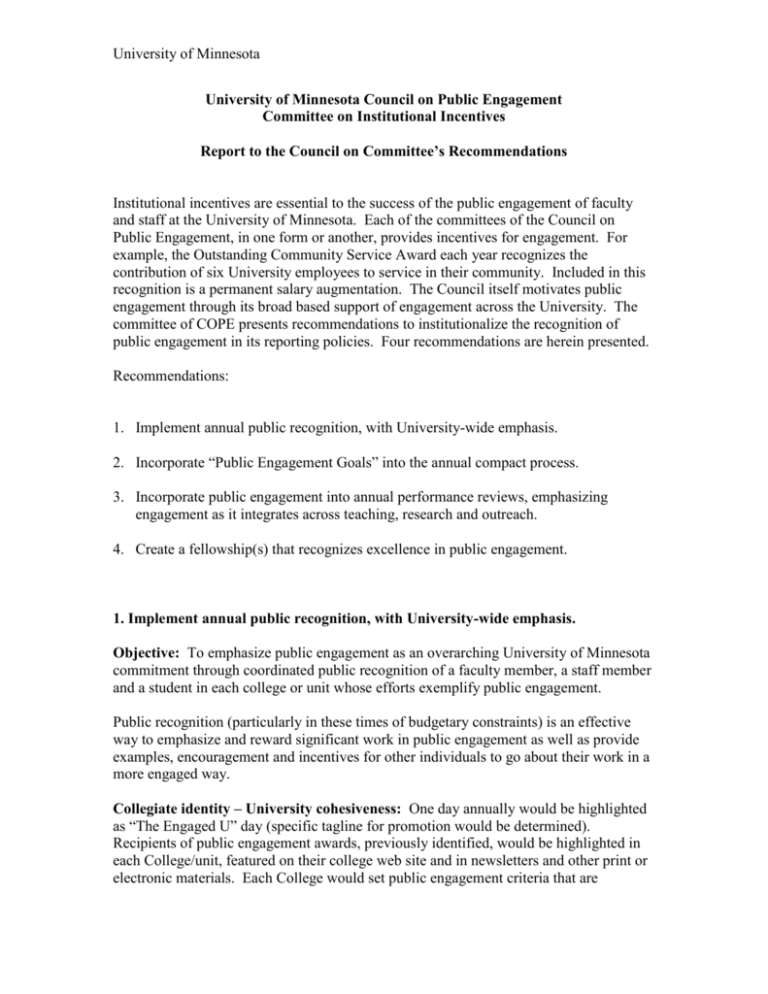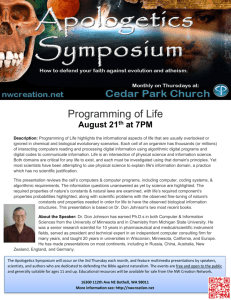institutional_incent..
advertisement

University of Minnesota University of Minnesota Council on Public Engagement Committee on Institutional Incentives Report to the Council on Committee’s Recommendations Institutional incentives are essential to the success of the public engagement of faculty and staff at the University of Minnesota. Each of the committees of the Council on Public Engagement, in one form or another, provides incentives for engagement. For example, the Outstanding Community Service Award each year recognizes the contribution of six University employees to service in their community. Included in this recognition is a permanent salary augmentation. The Council itself motivates public engagement through its broad based support of engagement across the University. The committee of COPE presents recommendations to institutionalize the recognition of public engagement in its reporting policies. Four recommendations are herein presented. Recommendations: 1. Implement annual public recognition, with University-wide emphasis. 2. Incorporate “Public Engagement Goals” into the annual compact process. 3. Incorporate public engagement into annual performance reviews, emphasizing engagement as it integrates across teaching, research and outreach. 4. Create a fellowship(s) that recognizes excellence in public engagement. 1. Implement annual public recognition, with University-wide emphasis. Objective: To emphasize public engagement as an overarching University of Minnesota commitment through coordinated public recognition of a faculty member, a staff member and a student in each college or unit whose efforts exemplify public engagement. Public recognition (particularly in these times of budgetary constraints) is an effective way to emphasize and reward significant work in public engagement as well as provide examples, encouragement and incentives for other individuals to go about their work in a more engaged way. Collegiate identity – University cohesiveness: One day annually would be highlighted as “The Engaged U” day (specific tagline for promotion would be determined). Recipients of public engagement awards, previously identified, would be highlighted in each College/unit, featured on their college web site and in newsletters and other print or electronic materials. Each College would set public engagement criteria that are University of Minnesota consistent with the culture and goals of that unit for selection of the recipient. However, all recipients would be featured on the University web site, with links to Colleges. The stories of each recipient and their work would provide a rich portfolio of examples of engagement across the University that both include and benefit citizens and the U. Additional promotion: Media and public information coordination through collegiate communicators would help ensure that public engagement day at the U was promoted to various media outlets and to special interest organizations, business, community and citizens groups, elected officials and others. Through the University of Minnesota Extension Service, information would be distributed in all counties of the state. The importance of public engagement at the University could be highlighted in editorials and in op-ed pieces by the President and Regents. Engagement could be emphasized through a series of articles in print or on radio or television. Events: Each college or unit might choose to feature a special event as part of public engagement day, emphasizing engagement specific to the college even as it is highlighted at the University umbrella level. Events might include a seminar or public address, a reception or special gathering. In this way, colleges could choose from the no-cost option of recognition, or offer an event based on budget flexibility. University Relations might choose to feature a University-wide event that features and further recognizes public engagement award recipients. A public participation component to events would be important. Tactics: COPE could develop general guidelines for timing and selection of public engagement award recipients. It would be critical for the Provost and President to emphasize the significance of a public engagement recognition day to the Deans as a way of rewarding high-quality effort among faculty, students and staff. Participation across all colleges and units would be essential for success and high visibility throughout the state. Financial investment would be minimal, although colleges would need to be prepared to commit staff time to recognition and any related event. 2. Incorporate “Public Engagement Goals” into the annual compact process. Purpose. The U of M Compact process is the primary structure for reporting priorities to the Provost. Since public engagement is a stated high priority of the U’s administration, it is very important that there be a formalized reporting structure within the Compact process that addresses public engagement. Currently, certain topics are required to be addressed in each college’s compact, topics such as diversity. In requiring a paragraph on pubic engagement in the document, the University would be making a statement of its importance to all of the colleges. University of Minnesota Proposal. It is recommended that the colleges be required to address the issue of the public engagement in the Compact planning process, citing both plans and metrics for accomplishments. 3. Incorporate public engagement into annual performance reviews, emphasizing engagement as it integrates across teaching, research and outreach. Annual reviews are required of all faculty and staff at the University of Minnesota. It is proposed that work in public engagement be reported explicitly. It is recognized that public engagement can be a part of all three missions: teaching, research, and service. It is recommended that public engagement be reported in the categories where it fits best and then referred to separately under the category of reporting, “public engagement.” The goal of this reporting is to instill a culture of public engagement in the University. The reporting is an effort to have faculty and staff think in terms of public engagement as they report work. Reporting is not intended to interfere with performance or tenure code standards, but rather to raise awareness of public engagement in the minds of the supervisors and persons being evaluated. The committee requests that the Council discuss our proposal that the University Senate address the recognition of public engagement as a form of scholarship. 4. Create a fellowship(s) that recognizes excellence in public engagement. Purpose. The purpose of this fellowship program would be to encourage University faculty, staff, and students to carry out research projects that involve significant issues of public policy for the state and/or its communities and that include engagement with groups, agencies, or organizations in Minnesota involved with the issue. Such issues will often have significance beyond the state but there should be some appropriate level of engagement with those in Minnesota. Good projects should grow out of the research interests of the faculty as well as addressing issues of importance to the state. Process. Faculty members will be invited to submit proposals including a statement concerning the nature of the project's public engagement. A selection committee representing both the University and the community will award the fellowships. Depending on the level of funding for the program, the fellowships can include support for released faculty time, graduate and/or undergraduate research assistance, appropriate research expenses, etc. Results. In addition to professional publications and other such outcomes, fellowship holders would be expected to make results and findings available through appropriate means to interested parties in the state.




